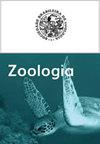Taxonomic re-evaluation of New World Eptesicus and Histiotus (Chiroptera: Vespertilionidae), with the description of a new genus
IF 1.8
4区 生物学
Q4 ZOOLOGY
引用次数: 2
Abstract
. Eptesicus Rafinesque, 1820 is widely distributed in the Old and New World (26 species), and Histio-tus Gervais, 1856 is a South American endemic (11 species). Molecular phylogenies have recovered Eptesicus (sensu lato) as polyphyletic, with New World Eptesicus and the sister genus Histiotus in a paraphyletic American clade sister to Old World Eptesicus . Based on these phylogenetic reconstructions, authors have treated Histiotus as either a subgenus of Eptesicus or restricted Eptesicus to the New World species, treating Histiotus as a full genus, and using the name Cnephaeus Kaup, 1829 at the generic rank to comprise Old World Eptesicus . Based on recently published molecular studies, and on novel qualitative and quantitative morphological comparisons of representatives of Histiotus and New and Old World Eptesicus , we provide evidence for restricting the name Eptesicus to the species E. fuscus (Palisot de Beauvois, 1796) and E. guadeloupensis Genoways & Baker, 1975, allocating the remaining New World species under a new genus, keeping Histiotus as a full genus, and raising Cnephaeus to generic rank to comprise all Old World taxa currently under Eptesicus . This arrangement resolves the paraphyly of New World Eptesicus , and promotes taxonomic stability for Histiotus , which is a well-established genus of easily recognizable Neotropical bats and treated separate from Eptesicus by most authorities.新属的描述及对新属的重新评价
本文章由计算机程序翻译,如有差异,请以英文原文为准。
求助全文
约1分钟内获得全文
求助全文
来源期刊

Zoologia
生物-动物学
自引率
0.00%
发文量
15
期刊介绍:
Zoologia, the scientific journal of the Sociedade Brasileira de Zoologia (SBZ), is an international peer-reviewed, open-access Zoological journal that publishes original research on systematics, evolution, taxonomy, nomenclature, biogeography, morphology, physiology, biology, ecology, symbiosis, conservation, behavior, genetics and allied fields. The journal, formerly known as Revista Brasileira de Zoologia, publishes original articles authored by both members and non-members of the Society. The manuscripts should be written exclusively in English.
 求助内容:
求助内容: 应助结果提醒方式:
应助结果提醒方式:


